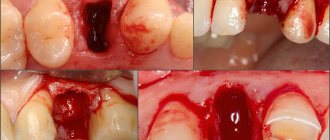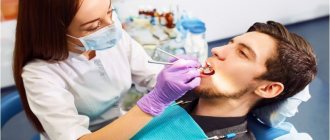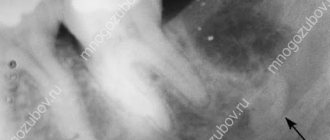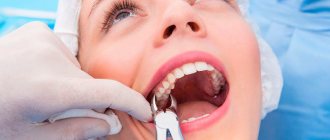Home → Articles → Recommendations after gum surgery
The dental team at the Stomatolog 11 clinic strongly advises that you follow all recommendations after gum surgery. Safe dental treatment using modern dental devices in the clinic creates conditions for a comfortable postoperative period. Maintain your oral health after surgery by following the tips below.
Sign up for a consultation at the dental clinic “Stomatolog11” in the Northern Administrative District:
Make an appointment
The drainage system is installed in stages:
- The painful area of the jaw is numbed.
- The gum is cut and a latex drain is inserted into it, through the hole of which the pus is sucked out.
- After suctioning out the pus, an antiseptic drug is injected into the gum incision.
- If a tooth is removed, the gum is not cut, but a drain is inserted into the socket.
How many days should I wear the drainage? Improvement may occur within 24 hours. On average, drainage costs from 3 to 5 days.
What to do if the tube falls out?
The patient must understand what happens during the drainage process. This is the only way he can respond to changes in time.
- If the dental drainage falls out on the first day of therapy, when the swelling has not yet gone away, you should urgently contact your dentist to install a new system. You cannot hesitate to visit a doctor, since the soft tissues quickly unite, preventing the pathological fluid from escaping.
- You should not return the structure to the wound yourself, so as not to cause additional infection and the development of serious complications.
- When the strip or tube falls out after 4-5 days, the swelling has already subsided, pus does not flow out of the wound, there is no need to worry. This means that the design has fulfilled its functions. But you need to see a doctor. He will monitor the patient’s condition and, if necessary, prescribe further treatment.
To prevent tooth drainage from causing inconvenience to the patient, it must be placed correctly. It is better for the patient to sleep on the healthy cheek, and not on the side where the operation was performed. This will not move the system away from the inflamed area. If you can’t see a doctor, the tumor has gone away, and there’s no pus coming out, you can try to remove the system yourself. To do this, stand in front of a mirror and, with great care, pry off the tube, pulling it smoothly towards you. But, it’s better not to take risks, but to find a way to get to the doctor and entrust this manipulation to a specialist.
Dentist advice
If you follow the doctor's recommendations, the effectiveness of the drainage system increases.
- After installing the drainage, you can eat only a few hours later. Food should be liquid.
- You can take a painkiller tablet to relieve pain.
- Drainage is installed when a purulent process occurs, so you should not apply a heating pad to your cheek. It is better to apply a cloth soaked in cool water
- It is better to sleep on the side opposite the side on which the drain is installed.
- If drainage is installed, it is better to stop smoking and drinking alcohol.
- Be careful when brushing your teeth.
- Avoid injuring the gums, as impacts can dislodge the drainage.
In order for the gums to heal well and without complications after removal of the drainage, the patient must follow the recommendations of the dentist, who can provide comprehensive assistance in the treatment of the inflammatory process that occurs at the root of the tooth or in the gum.
Basic recommendations after gum incision
Implantation, tooth extraction, or opening of purulent foci is not possible without an incision in the gums. This stressful situation for the oral cavity causes considerable discomfort for a person.
Recommendations after gum incision:
- On the first day, you need maximum peace and rest;
- For 3 hours, all drinks and food should be excluded;
- In the first 3 days, hard and hot foods should be excluded, as well as excessive facial expressions;
- Any physical activity, especially those leading to blood flow to the head, should be avoided;
- Also, exclude hot relaxing baths, saunas and steam baths;
- For 7 days you need to strictly limit your intake of tobacco and alcoholic beverages;
- It is strictly forbidden to apply hot compresses to the wound or cauterize it with alcohol-containing solutions.
What to do if complications arise after gum surgery:
- Edema. Always occurs during implantation or after removal of a wisdom tooth. Small to medium edema is a normal reaction of the body. If the swelling is severe, then you need to consult your doctor to rule out the onset of alveolitis.
- Temperature. The temperature that rises a few hours after the gum incision can reach 37.5 °C, which is considered normal. However, if it goes beyond 38 °C, it may indicate the onset of the inflammatory process. In this case, you should consult a doctor to prescribe a course of antibiotics.
- Bleeding. After surgery, a blood clot usually forms to prevent bacteria from entering the socket. Bleeding occurs as a result of vascular damage or capillary fragility. To stop the bleeding, apply a thick sterile bandage to the problem area. If the bleeding does not stop, you should call a doctor.
- Pain. Natural response to surgery. The pain can be moderate or very severe. In any case, to reduce it you need to take a painkiller pill.
Dental clinic Stomatolog 11 in Moscow offers a wide range of services in orthodontics, therapeutic dentistry, and implantation. It is also popular to make an appointment with a pediatrician and for teeth whitening.
Treatment using innovative dental devices and careful attitude towards each client allows us to minimize the risks of any complications after dental interventions. You can see the work performed by a team of true professionals in the photos posted on our website and in social groups.
Choose high-quality and safe dental services in our clinic. Ensure your dental health.
Free consultation
How to remove drainage yourself and is it possible to do it?
Despite the fact that very small tubes are used today, they are still felt in the mouth and cause some discomfort to the patient. Many people complain of difficulties eating and pronouncing sounds. Therefore, the first thing that worries most patients in such a situation is when the drainage can be removed, how to remove it yourself, and whether it hurts to deliver this tube yourself. Of course, it is better to entrust this to a doctor who knows exactly how to correctly remove the structure from the incision and how to change it, if necessary. However, the patient himself can do this; the doctor warns him about this immediately after the installation is completed and gives recommendations on how to remove the structure if necessary. In addition, the drainage often falls out on its own. Here are some important tips on how to carry out the procedure yourself:
- wash your hands thoroughly and treat them with a disinfectant, you can use special dental gloves,
- rinse your mouth with an antiseptic to disinfect the tissue surrounding the wound,
- stand in front of the mirror and gently grab the outer part of the strip with your fingers, then carefully pull it towards you.
After removal, it is advisable to rinse your mouth with an antiseptic.
Does it hurt to remove drainage from the gums? In fact, this is a simple procedure, which, however, can cause some pain and cause bleeding. Experts advise rinsing your mouth with some antiseptic for some time after removing the drainage. If bleeding does not stop within more than 2 hours after removing the strip, you should urgently go to the doctor.
Difficult removal
Removing a wisdom tooth in the lower jaw is often difficult. The operation differs in its duration, the use of a special instrument, and the use of a drill. Often the tooth is sawed and removed in parts. In this case, the figure eight is incorrectly positioned or impacted. Removal consists of the following steps:
- High-quality pain relief;
- Preparation of tools and auxiliary materials;
- Separating the tooth ligament or creating access;
- Application and fixation of forceps;
- Extraction of a molar in whole or in parts;
- Inspection of the bone socket, cleaning it if necessary;
- Stop bleeding;
- Stitching;
- Prescriptions and recommendations for the patient.
When you need to remove the bottom "eight". Indications
Wisdom teeth are distinguished by late eruption, which occurs at 20-30 years of age. During this period, the dental system is practically formed and the third molars often do not have enough space in the dentition. Eruption causes various complications and in most cases requires removal of the molar. In addition, in humans, with evolution, a decrease in the size of the jaws occurs, since, due to the nature of nutrition, the chewing load is constantly decreasing.
Most people do not take good hygienic care of their last teeth. They are located at the end of the dentition, and it is often technically impossible to clean them well. This leads to the accumulation of plaque, damage to the enamel by the carious process and its complications (pulpitis, periodontitis). Root canal treatment is very difficult due to difficult access. Therefore, eights must be removed in 90% of cases.
Removal of a fully erupted wisdom tooth
Removal of the lower wisdom tooth is indicated in the following cases:
- Excessive pressure on neighboring teeth, which can lead to their destruction;
- Injury to surrounding tissues;
- Constant biting of the mucous membrane of the cheek;
- Carious lesion that cannot be eliminated due to difficult access;
- Complications of caries: pulpitis, periodontitis, periostitis;
- Dystopia – location of the molar outside the dentition;
- A tooth that is a chronic source of infection;
- Formation of perihilar cysts, granulomas;
- Malocclusion and displacement of other teeth.
Tooth dislocation in a child
Luxation of a baby tooth is a common injury in children 1-3 years old. Children often fall when hit by hard objects. The symptoms are not fundamentally different from those in adults. The most dangerous is an impacted luxation of a baby tooth, since this can lead to destruction of the dental bottom, which in the future will prevent the normal development of a permanent tooth. If an accident does happen to a child, you cannot set the tooth yourself - there is a high risk of causing even greater injury. You should contact the dentist.
Differential diagnosis of tooth dislocation at SM-Dentistry
Only an experienced dentist can diagnose a tooth dislocation and distinguish it, for example, from a crown fracture. Usually, not only the tooth itself is injured, but also the tissues surrounding it. In particular, a crack may form in the jawbone. In any case, an objective examination is needed to assess the patient’s condition and the possible consequences of the injury.
The SM-Dentistry doctor will examine the injured area and offer diagnostics using modern equipment:
- dental x-ray of the tooth;
- computed tomography (panoramic image using the Galileos device);
- three-dimensional x-ray examination of the maxillofacial area using the Vatesh apparatus.
When will the gums heal?
This question interests many patients. The rehabilitation period after molar tooth extraction can be longer or shorter. This depends on the severity of the operation, the amount of collected pus, the condition of the gum tissue, and the presence of chronic diseases. In difficult cases, the patient will have to visit the doctor every day so that the dentist cleans the wound and administers a dose of the drug. If there are no complications, the gum tissue heals quickly. For some people, the healing process takes 3-4 days. It happens that complete rehabilitation takes a week or ten days.
The doctor may prescribe treatment of the oral cavity with an antiseptic solution to prevent the development of infection in the mucous membrane. For this purpose, miromistin and hydrogen peroxide are used. Soda solution, Cholisal gel, and chlorophyllipt solution are also suitable. The ointment used is solcoseryl and levomikol. According to indications, antibiotics such as Lincomycin, Doxycycline, Amoxiclav are prescribed. For unbearable pain, you can use Tempalgin, Ibuprofen, Ketanov according to the instructions. If you follow medical recommendations, healing occurs quickly.









